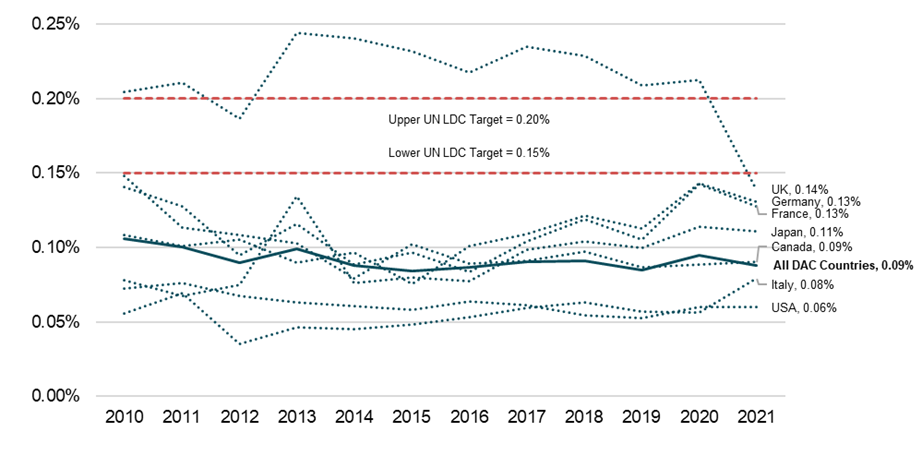Recommended
Next week, a once-in-a-decade UN conference will meet to address the challenges facing Least Developed Countries (LDCs). It will plan delivery of the Doha Programme of Action (PoA), and review implementation of the Istanbul PoA. As part of this, attention should be given to a set of lesser-known UN aid targets for LDCs, agreed at previous conferences, where donor countries committed to provide over either 0.15 or 0.2 percent of their economic output.
In this blog, we look at performance against these targets for the core group of donor countries in the Development Assistance Committee (DAC). We not only find an overall lack of progress towards these targets, but even some evidence of regression. Over the last decade, the UK has been the only major G7 economy to ever meet these targets – yet even here, with its significant aid cuts in 2021, that achievement was lost.
The UN Conference on LDCs and its Aid Targets
The development challenges facing LDCs have hardened in recent years. The number of people living in extreme poverty has increased over its pre-pandemic trend, through the combined effects of the COVID-19 pandemic, Russia’s invasion of Ukraine, and inflationary pressures. The share of low-income countries assessed as being at high risk of or already in debt distress has doubled since 2015, up to almost 60 percent in 2021. And the Doha PoA has recognised that LDCs are not on track to meet the Sustainable Development Goals by 2030.
But next week, the fifth UN conference on LDCs (LDC5) provides an opportunity to look back over the last decade and plan for the coming one. The implementation of the previous Istanbul PoA will be assessed, whilst new actions and partnerships are agreed to deliver the Doha PoA. As part of this, aid flows to LDCs should receive considerable attention.
At the previous UN conference on LDCs in 2011, donor countries recommitted themselves to a set of targets on the share of GNP provided as Official Development Assistance (ODA) to LDCs. Donors already providing more than 0.20 percent pledged to continue to do so (whilst also making efforts for further increases); those providing between 0.15 to 0.20 percent pledged to reach 0.20 percent; and others pledged to reach 0.15 percent. These targets were already longstanding in 2011: similar commitments had been made in the earlier 1990 and 2001 conferences – and the lower target of 0.15 percent stretches all the way back to the first UN conference on LDCs in 1981.
Donor Countries Mostly Didn’t Fulfil Their Commitments to LDCs
Yet since recommitting to these UN LDC targets in 2011, the share of GNI provided as ODA to LDCs has stagnated for the core group of donor countries in the Development Assistance Committee (DAC). In fact, it even fell slightly between 2011 and 2021: from 0.10 to 0.09 percent of their combined GNI. Whereas seven of the 29 DAC member countries met the UN’s upper target of 0.2 percent in 2011, by 2021 only four did. And whilst in 2011 a further three also met the lower target of 0.15 percent, this was down to just one in 2021.
Besides the UK, no other major G7 economy has even reached the lower of the UN’s targets: over the last decade Canada, France, Germany, Italy, Japan, and the United States have never provided even 0.15 percent. In contrast, for nine of the ten years between 2011 to 2020, the UK has exceeded the upper UN target of 0.2 percent. But with significant cuts to UK aid in 2021, its exceptional position has now been lost. Official data now reveals that last year the UK dramatically reduced its share of GNI provided as ODA to LDCs: from 0.21 percent in 2020 to 0.14 percent in 2021. After eight years of consistently exceeding the upper UN LDC target, the UK now doesn’t even meet the lower one.
Figure 1: Share of GNI provided as ODA* to LDCs vs UN targets; for G7 donors and all DAC countries
Source: CGD analysis of OECD DAC1 & DAC2a tables
* Note: Net ODA disbursements, including imputed multilateral flows.
This coincides with the significant reduction in the overall UK aid budget, cut from 0.7 to 0.5 percent of GNI in 2021. Perhaps even more concerningly: it also reflects a reallocation within the aid budget away from the poorest countries, which we have recently highlighted. As part of this, the share of UK ODA allocated to LDCs fell from 29 to 26 percent between 2020 and 2021.
Though four other DAC countries still exceeded the UN’s upper target in 2021 – Luxembourg (0.45 percent), Sweden (0.32 percent), Norway (0.25 percent), and Denmark (0.22 percent) – and the lower target was also exceeded by Finland (0.16 percent). These countries deserve significant credit for prioritising the poorest and set an example to be followed; but if the development challenges of LDCs are to be met, a wider group of provider countries must fulfil their ODA commitments.
Looking Forward for the UK
Last Summer, the UK reaffirmed its commitment to LDCs in its latest Strategy for International Development, which promised: “We will continue to support the global goal of providing at least 0.2% of our gross national income (GNI) to the Least Developed Countries.” And since then, the new Development Minister Andrew Mitchell has also declared his “focus on the poorest and most vulnerable”.
With the UK’s aid budget not expected to return to 0.7 percent of GNI before 2028, meeting the upper UN target of providing 0.2 percent to LDCs would require a major reprioritisation of resources. At least 40 percent of UK aid would need to be allocated to LDCs so long as the total budget remains at 0.5 percent of GNI – significantly above the 2021 level of 26 percent. And before improving, the UK’s performance against these targets will likely further worsen, as a significant share of 2022 ODA is diverted to support in-donor refugee costs, causing cuts elsewhere. But if UK aid is to reverse the decline in its poverty focus, highlighted by our recent analysis, it must more strongly prioritise lower-income countries in its allocation process – and an ongoing commitment to the UN LDC targets will encourage this.
Disclaimer
CGD blog posts reflect the views of the authors, drawing on prior research and experience in their areas of expertise. CGD is a nonpartisan, independent organization and does not take institutional positions.
Image credit for social media/web: Adobe Stock







